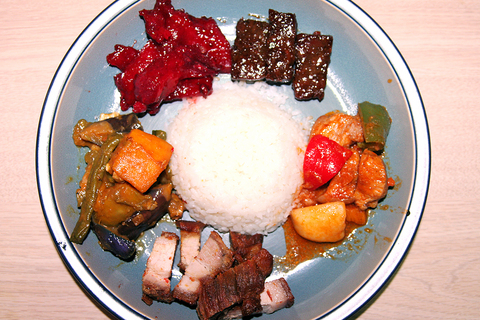Food from the Philippines rolls off the tongue as a phrase but it doesn't have the mouthwatering associations that, say, Thai, Vietnamese or even Indonesian cuisines have. Most people would be hard pressed to name one famous dish from the country. This is odd, in some respects, since it has had so many culinary influences, ranging from China to Mexico and Spain.
Possibly the best place in town to get better acquainted with Filipino food is Cres-art (CA) on Zhongshan North Road's section three. On Sunday the area turns into Little Manila and the place is so packed customers end up on the pavement outside eating from Styrofoam dishes.
Named after owner Imelda Ching's parents, it was Cresencia and Arturo who taught the young girl how to cook at their family restaurant in the Philippines. Catering, she said, is in her blood. She offered an enticing assortment of dishes, along with plain boiled rice.

PHOTO: JULES QUARTLY, TAIPEI TIMES
Filipinos love the salt and sour combination and Mang Tomas' All-Around Sarsa condiment is an example of this. Made principally from breadcrumbs, vinegar and liver, it goes with most meats. The fried fatty pork lechon kawali, with crackling on the outside, was served in bite-sized slices. It was intensely rich and tasty, as you might imagine, and paired beautifully with Mang Tomas and a sweet chilli sauce. The peppery skinless sausages, or longanisa, were homemade and coated with soy sauce. The pork apritada was braised with tomatoes, onions and bell peppers, carrots and (again) a little vinegar.
The Filipino beefsteak came with a dash of lemon, soy sauce and onion gravy and was a winner. Pinkbet was a mixture of aubergine, squash, eggplant, green beans and bitter gourd, mixed with shrimp paste, garlic and onion. It had a complicated taste unlike anything else. Milkfish, apparently, is the Philippine's national sea dish and was marinated overnight in lemon, vinegar and garlic before being fried until the outside was brown. A purple confection called ube halaya was made from taro, butter, milk and sugar and was a sweet ending to the meal. Authentic tastes extended to the drinks selection and the zesty lemon Calmansi was refreshing.
Christian figurines decked with garlands, a Babel-like mix of languages, green plastic seats and Formica tables, plus a soundtrack from the disco era signaled a cheap but cheerful ambiance that is recommended.

Exceptions to the rule are sometimes revealing. For a brief few years, there was an emerging ideological split between the Democratic Progressive Party (DPP) and Chinese Nationalist Party (KMT) that appeared to be pushing the DPP in a direction that would be considered more liberal, and the KMT more conservative. In the previous column, “The KMT-DPP’s bureaucrat-led developmental state” (Dec. 11, page 12), we examined how Taiwan’s democratic system developed, and how both the two main parties largely accepted a similar consensus on how Taiwan should be run domestically and did not split along the left-right lines more familiar in

As I finally slid into the warm embrace of the hot, clifftop pool, it was a serene moment of reflection. The sound of the river reflected off the cave walls, the white of our camping lights reflected off the dark, shimmering surface of the water, and I reflected on how fortunate I was to be here. After all, the beautiful walk through narrow canyons that had brought us here had been inaccessible for five years — and will be again soon. The day had started at the Huisun Forest Area (惠蓀林場), at the end of Nantou County Route 80, north and east

Specialty sandwiches loaded with the contents of an entire charcuterie board, overflowing with sauces, creams and all manner of creative add-ons, is perhaps one of the biggest global food trends of this year. From London to New York, lines form down the block for mortadella, burrata, pistachio and more stuffed between slices of fresh sourdough, rye or focaccia. To try the trend in Taipei, Munchies Mafia is for sure the spot — could this be the best sandwich in town? Carlos from Spain and Sergio from Mexico opened this spot just seven months ago. The two met working in the

This month the government ordered a one-year block of Xiaohongshu (小紅書) or Rednote, a Chinese social media platform with more than 3 million users in Taiwan. The government pointed to widespread fraud activity on the platform, along with cybersecurity failures. Officials said that they had reached out to the company and asked it to change. However, they received no response. The pro-China parties, the Chinese Nationalist Party (KMT) and Taiwan People’s Party (TPP), immediately swung into action, denouncing the ban as an attack on free speech. This “free speech” claim was then echoed by the People’s Republic of China (PRC),